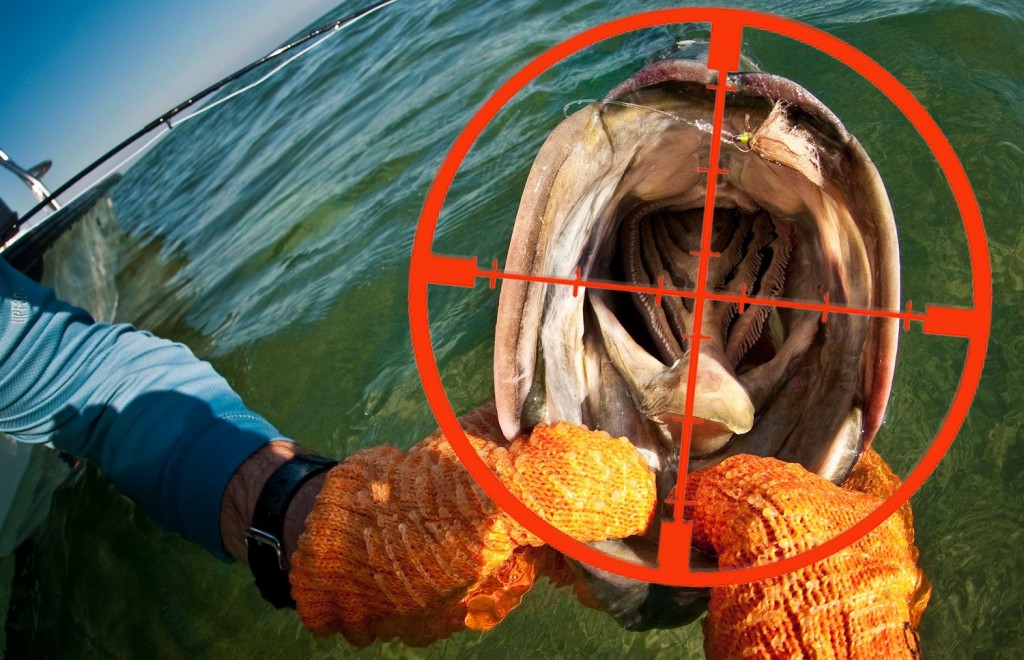
Are you reading the tarpon correctly and presenting your fly in the right spot? Photo By: Louis Cahill
Anyone who’s fly fished for tarpon has probably experienced how easy it is to present the fly incorrectly.
If you miss your target, even by just a little bit, it can drastically lower your chances for getting a tarpon to eat. Cast the fly too close, and the tarpon will spook. Don’t lead the fish enough, and your fly won’t get down to the tarpon’s depth. Cross the fish at the wrong angle, and your fly will be moving towards the fish and it will spook. The list goes on and on.
Bottom-line, there’s a very small margin of error bestowed to anglers fly fishing for tarpon. You have to execute everything damn near perfect to put the odds in your favor, and even then, you aren’t guaranteed squat. Here’s the problem. The average angler that travels to fly fish for tarpon is not educated on how to read and respond accordingly to different fishing scenarios on the flats. A lot of this has to do with lack of experience and time on the water. If you find yourself falling into this category, prior to fishing, you should take the time to have your guide explain how you should handle common fishing situations that you’re likely to encounter. As a kid the same preparation was used by my Dad to walk me through how to make a clean kill shot on a deer. I can hear him now, “If the deer is faced in this direction, I want you to put the crosshairs here“. He must have gone over a dozen different scenarios during the drive up. By the time he was done talking, I felt like I had been hunting for years. It’s no different fly fishing for tarpon. Taking the time to have your guide walk you through different fishing scenarios will greatly increase your tarpon insight, fishing awareness and get you prepared for the real McCoy.
The second thing anglers should do to increase their success tarpon fishing is have a solid game plan or checklist that they’re willing to stick to on the bow. It must run like clockwork, flawlessly and consistently every time. The game plan should begin at the angler ready position, with fly in hand, and end with a well-calculated presentation cast. Success all boils down to angler aptitude and experience. The more you have of it, the better the chances you’re going to make the right calculations and decisions on the water.
I gave my good friend and Florida Keys flats guide, Captain Joel Dickey a call to look over my checklist and give me some pointers. Below is a checklist we came up with that every saltwater angler on the bow should follow closely to increase his/her chances at placing their fly in the right target zone, and maximize their hookup ratio.
Tip 1: Make sure your fly is not fouled on the hook and you have your fly line laid out organized in the ready position.
Tip 2: Figure out where the tarpon is located and the direction it’s facing or moving (left, right, straight at you, quartered away, ect.)
Tip 3: When time is available always let your guide get the boat into position before you cast.
Tip 4: Always allow your guide to help you zero in on your target during your false casting, especially if you lose sight of the fish.
Tip 5: Pay attention to the clarity of the water. The clearer the water the farther you should lead the tarpon.
Tip 6: Determine the direction and speed of the current (tide). A strong current may call for leading a tarpon 10′ or more, while a slow current could be as little as 5-6′.
Tip 7: Don’t forget about the wind during your presentation. If you have a heavy crosswind you’ll need to take that into factor when aiming.
Tip 8: Never cross the fish with your fly line. In most cases the tarpon will see the shadow of your fly line and spook.
Tip 9: Calm flat water calls for fly placement farther away from the tarpon. Choppy water conditions you can get away with placing your fly closer to the fish.
Tip 10: Never have your fly moving towards the fish. Most tarpon prey don’t do this and often it will spook the fish.
Tip 11: It’s not only important that you lead the fish but also cross the fish with your fly and leader. This allows you to bring your fly into the tarpons field of vision at the correct depth and time frame.
FYI: I was going to break down every tip in detail with examples but that would have made this post go on forever. If there’s anyone out there that would like me to elaborate on any specific tip please feel free to drop me an email and I’ll go into more detail.
More Posts on Tarpon Fishing
- 4 Tips For Getting Better Hookups With Tarpon
- Tropical Storms and Hurricanes Can Create Epic Fishing
- Don’t Get Mad Get Even
- Fly Fishing for Tarpon and the Importance of Confidence
- A Closer Look, The Silver King
Keep it Reel,
Kent Klewein Gink & Gasoline www.ginkandgasoline.com hookups@ginkandgasoline.com Sign Up For Our Weekly Newsletter!